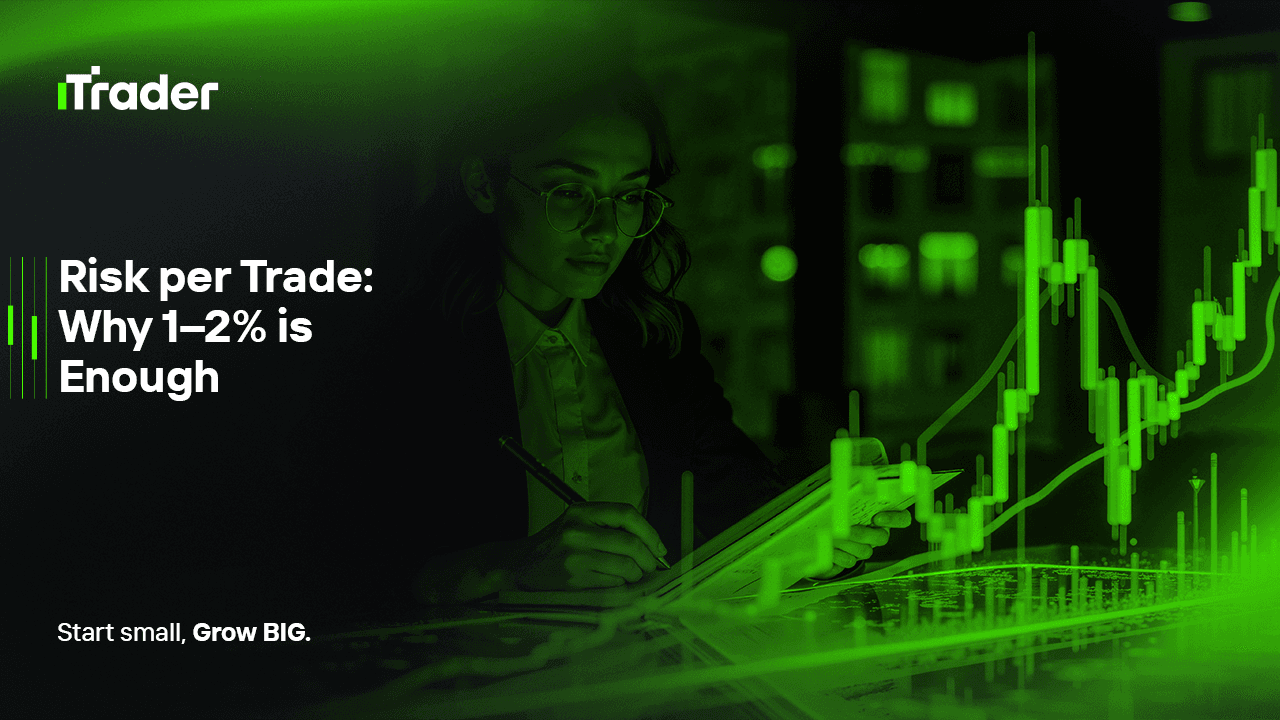2025-09-11
In forex trading, many traders focus on building profitable strategies, finding the best indicators, or identifying precise entry and exit points. Yet, the single most critical factor behind long-term success is risk management. The trader’s first goal is not to make money but to protect capital. This leads to the fundamental question: “How much of my account should I risk on a single trade?”

While there are many opinions, most professional traders and prop firm mentors agree on one golden rule: risking only 1–2% of your account per trade.
This blog will explain why that range has become the professional standard, backed by mathematics, psychology, and practical experience. We’ll also explore how this rule applies in the context of prop firm challenges, where strict drawdown rules demand disciplined risk control.
Risk per trade is the percentage of your trading account you are willing to lose if a trade goes against you.
For example:
This percentage determines not only your survival but also your ability to remain in a prop firm challenge, where strict daily and overall loss limits are enforced.
The 1–2% rule is based on statistical survival. It keeps losses small and recoverable.
As Warren Buffett famously said:
Preserving capital is the foundation of longevity in trading.
The probability of blowing an account (Risk of Ruin) grows exponentially when risk per trade increases. By keeping it within 1–2%, this probability becomes negligible, even through extended losing streaks.
Risking 5–10% per trade can quickly put an account into deep drawdown. Just a few losing trades may render recovery mathematically and psychologically impossible.
Large losses create fear and frustration, which disrupt discipline and often trigger impulsive decisions.
Traders who take oversized risks often try to “make it back quickly” with even larger positions. This is the fastest way to blow an account.
Prop firms like FTMO and MyForexFunds impose strict risk parameters:
If you risk 5% per trade, one bad trade could cause immediate failure. By keeping risk to 1–2%, you allow room for multiple trades and reduce the chance of disqualification.
Profitability is measured by expectancy:
Expectancy=(WinRate×AverageWin)–(LossRate×AverageLoss)Expectancy = (Win Rate × Average Win) – (Loss Rate × Average Loss)Expectancy=(WinRate×AverageWin)–(LossRate×AverageLoss)
With 1–2% risk, your losses remain small, and profitable trades can expand the account through favorable risk-to-reward ratios.
Keeping risk fixed at 1–2% allows for proper position sizing and consistent exposure, regardless of strategy or market volatility.
Let’s take a $100,000 prop firm challenge:
Clearly, the 1–2% approach provides far more breathing room.
The 1–2% rule is not just a guideline; it is a professional standard grounded in:
In trading, survival comes before profit. By keeping risk low, you buy yourself time for your edge to materialize. The 1–2% risk rule is the safest and most effective path to long-term consistency.
© 2025 iTrader Global Limited | 회사 등록번호: 15962
iTrader Global Limited는 코모로 연방 앙주앙 자치섬의 무잠두(Hamchako, Mutsamudu)에 위치하고 있으며, 코모로 증권위원회(Securities Commission of the Comoros)의 인가 및 규제를 받고 있습니다. 당사의 라이선스 번호는 L15962/ITGL입니다.
iTrader Global Limited는 “iTrader”라는 상호로 운영되며, 외환 거래 활동에 대한 인가를 받았습니다. 회사의 로고, 상표 및 웹사이트는 iTrader Global Limited의 독점 재산입니다.
iTrader Global Limited의 다른 자회사로는 iTrader Global Pty Ltd가 있으며, 이 회사는 호주 회사 등록번호(ACN): 686 857 198을 보유하고 있습니다. 해당 회사는 Opheleo Holdings Pty Ltd의 공식 대리인(AFS 대표 번호: 001315037)이며, Opheleo Holdings Pty Ltd는 호주 금융서비스 라이선스(AFSL 번호: 000224485)를 보유하고 있습니다. 등록 주소는 Level 1, 256 Rundle St, Adelaide, SA 5000입니다.
면책 조항: 이 회사는 본 웹사이트에서 거래되는 금융 상품의 발행인이 아니며 이에 대해 책임을 지지 않습니다.
위험 고지: 차액결제거래(CFD)는 레버리지로 인해 자본 손실이 빠르게 발생할 수 있는 높은 위험을 수반하며, 모든 사용자에게 적합하지 않을 수 있습니다.
펀드, CFD 및 기타 고레버리지 상품의 거래에는 전문적인 지식이 요구됩니다.
연구 결과에 따르면 레버리지 거래자의 84.01%가 손실을 경험하고 있습니다. 거래에 참여하기 전에 관련 위험을 충분히 이해하고 전체 자본을 잃을 준비가 되어 있는지 확인하십시오.
iTrader는 레버리지 거래로 인해 발생하는 손실, 위험 또는 기타 피해에 대해 개인 또는 법인에게 전적인 책임을 지지 않음을 명시합니다.
이용 제한: iTrader는 해당 활동이 법률, 규제 또는 정책에 따라 금지된 국가의 거주자를 대상으로 본 웹사이트나 서비스를 제공하지 않습니다.